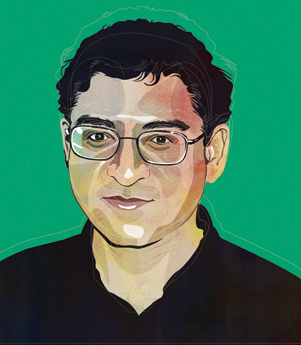Prabal Dutta Named to Popular Science’s Brilliant Ten List
Dutta designs hardware and software for smart dust and larger sensors that don't need batteries because they can harvest energy from the world around them.

 Enlarge
Enlarge
Professor Prabal Dutta has been named one of Popular Science’s 2014 Brilliant Ten for his work in developing energy scavenging sensors that could help herald the Internet of Things. The annual list recognizes “tomorrow’s Einsteins, Zuckerbergs and Marie Curies,” according to a news release. “Remember their names: they are already changing the world as we know it.”
Prof. Dutta designs hardware and software for smart dust and larger sensors that don’t need batteries because they can harvest energy from the world around them. They can run on power from the light in a room, the magnetic field around an electrical wire, or the heat from a shower head, for example.
In one project, he and his students are using hundreds of these sensors to track which household appliances and building systems are using the most electricity. It’s a step toward smart buildings that report the details of their energy consumption in real time, Prof. Dutta says. Most of the nation’s electricity use can be traced to buildings and Prof. Dutta says sensor systems like his could one day help consumers make smarter energy choices.
One of his ideas helped Japanese citizens keep tabs on radiation levels after Fukishima. In 2010, Prof. Dutta released HiJack, a device that let users transfer data and power sensors through the headset jack of a smartphone. Thousands used radiation sensors that incorporated the HiJack design to map the accident’s fallout.
“There was no other way for citizens to figure out whether it was safe to go home but to take their own measurements,” Prof. Dutta said. “A lot of our work is trying to empower people to take measurements of physical processes that matter to them.”
Prof. Dutta’s technologies scale down to the very small. His architectures are enabling millimeter scale computers, among the tiniest in the world. So-called smart dust could one day be embedded all around us, helping us monitor our environments and letting us Google the Internet of Things.
The Internet of Things refers to connected computing systems embedded in the physical world – things like medical implants and smart thermostats, FitBits, and even smartphones. Analysts predict it will grow as computing technology continues to shrink.
“Replacing the batteries on these things will become the Achilles Heel, so I don’t think we can scale it up to tens or hundreds or thousands of devices per person without solving the power problem,” said Prof. Dutta. “And a lot of our projects are working to do that.”
He is humbled at this recognition. “Of course, it’s an honor,” Prof. Dutta said. “But really, awards like this motivate you to live up to the expectations.”
 MENU
MENU 
